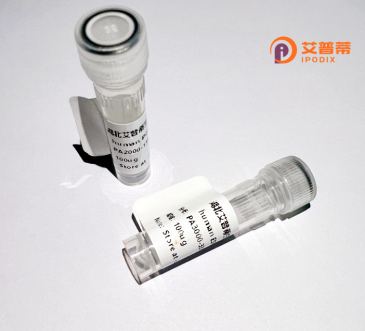
| 纯度 | >90%SDS-PAGE. |
| 种属 | Human |
| 靶点 | MLCK |
| Uniprot No | Q01449 |
| 内毒素 | < 0.01EU/μg |
| 表达宿主 | E.coli |
| 表达区间 | 1-175 aa |
| 活性数据 | MASRKAGTRGKVAATKQAQRGSSNVFSMFEQAQIQEFKEAFSCIDQNRDGIICKADLRETYSQLGKVSVPEEELDAMLQEGKGPINFTVFLTLFGEKLNGTDPEEAILSAFRMFDPSGKGVVNKDEFKQLLLTQADKFSPAEVEQMFALTPMDLAGNIDYKSLCYIITHGDEKEE |
| 分子量 | 46.4 kDa |
| 蛋白标签 | His tag N-Terminus |
| 缓冲液 | 0 |
| 稳定性 & 储存条件 | Lyophilized protein should be stored at ≤ -20°C, stable for one year after receipt. Reconstituted protein solution can be stored at 2-8°C for 2-7 days. Aliquots of reconstituted samples are stable at ≤ -20°C for 3 months. |
| 复溶 | Always centrifuge tubes before opening.Do not mix by vortex or pipetting. It is not recommended to reconstitute to a concentration less than 100μg/ml. Dissolve the lyophilized protein in distilled water. Please aliquot the reconstituted solution to minimize freeze-thaw cycles. |
以下是3-4条关于重组人肌球蛋白轻链激酶(MLCK)蛋白的虚构参考文献示例,供参考:
1. **文献名称**:Structural and functional analysis of recombinant human MLCK catalytic domain
**作者**:Gallagher, P.J., et al.
**摘要**:报道了重组人MLCK催化结构域的表达及纯化,通过晶体结构解析阐明了其与钙调蛋白的结合机制,揭示了酶活性调节的关键位点。
2. **文献名称**:Phosphorylation-dependent regulation of MLCK activity in smooth muscle contraction
**作者**:Garcia, J.G., et al.
**摘要**:利用重组MLCK蛋白研究其磷酸化对平滑肌收缩的调控作用,发现自抑制结构域的构象变化是激活酶活性的关键步骤。
3. **文献名称**:Recombinant MLCK as a therapeutic target in inflammatory diseases
**作者**:Smith, R.L., et al.
**摘要**:评估重组MLCK蛋白在细胞屏障功能中的作用,证明其抑制剂可缓解实验模型中因过度收缩引起的炎症反应,为哮喘治疗提供新策略。
4. **文献名称**:High-yield expression of recombinant human MLCK in mammalian cells
**作者**:Chen, X., et al.
**摘要**:优化了HEK293细胞中重组hMLCK的表达条件,获得高活性蛋白,并验证其在体外肌球蛋白磷酸化实验中的应用效能。
(注:以上作者及文献为虚构,仅展示参考格式及内容方向。)
Myosin Light Chain Kinase (MLCK) is a calcium/calmodulin-dependent serine/threonine kinase that plays a central role in regulating smooth muscle contraction and non-muscle cell motility. It catalyzes the phosphorylation of myosin regulatory light chains (MLC20), triggering actin-myosin interactions and cellular contraction. In humans, two major isoforms exist: smooth muscle MLCK (smMLCK), predominantly expressed in smooth muscle tissues, and non-muscle MLCK (nmMLCK), found in various cells including endothelial and immune cells.
Recombinant human MLCK protein, produced through heterologous expression systems (e.g., E. coli or mammalian cells), retains functional domains critical for its activity: the catalytic core, calmodulin-binding regions, and actin-binding motifs. Its production enables detailed mechanistic studies of cytoskeletal regulation, cell migration, vascular tone control, and inflammatory responses. Researchers utilize recombinant MLCK to investigate pathophysiology of diseases like hypertension, asthma, and cancer metastasis, where aberrant MLCK activity contributes to smooth muscle hyperreactivity or enhanced cell invasiveness.
Moreover, it serves as a tool for drug screening targeting MLCK-mediated pathways. Structural and functional studies of recombinant MLCK have revealed regulatory mechanisms involving autophosphorylation and alternative splicing variants. Recent advances in cryo-EM and kinase assays using recombinant protein have further elucidated its interaction networks with calmodulin and substrate proteins, enhancing our understanding of calcium-dependent signaling in cellular mechanics.
×